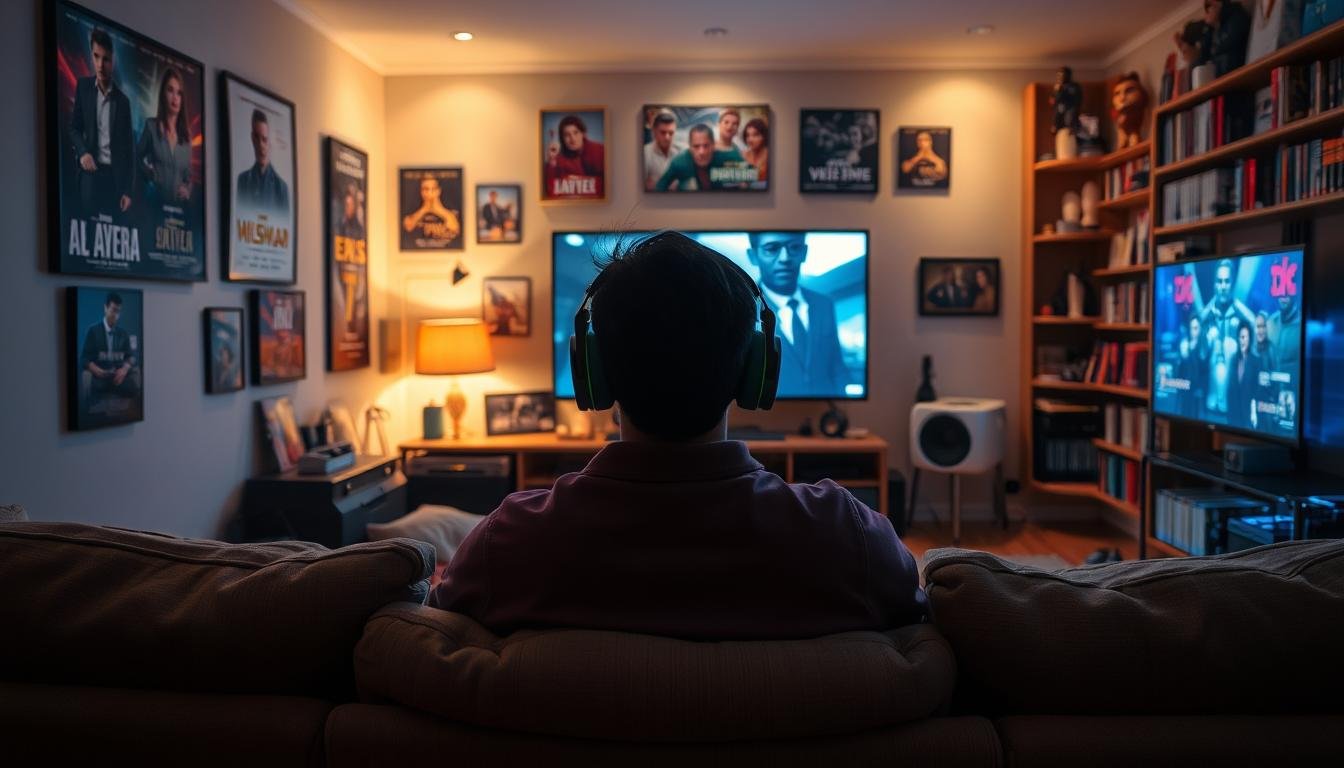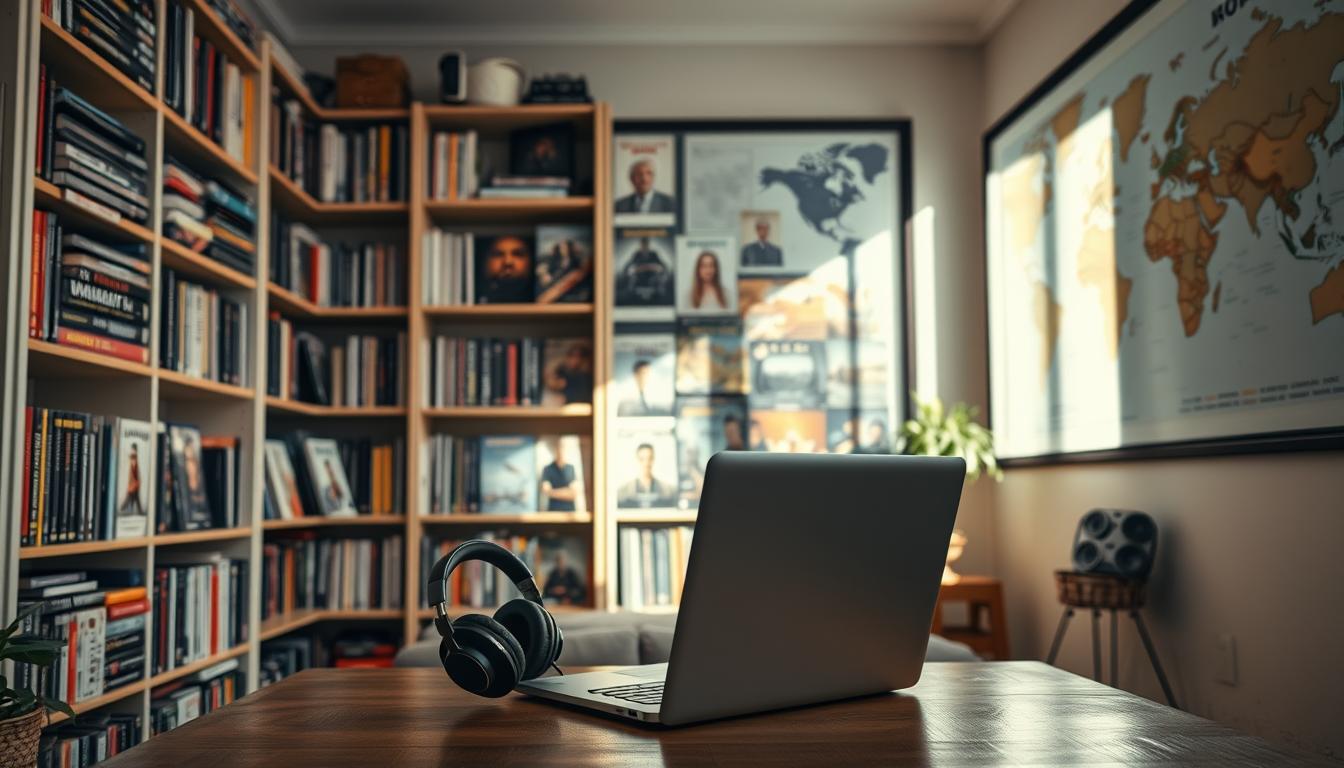Now Reading: How to Use Movies and TV Shows to Train Your Ears
-
01
How to Use Movies and TV Shows to Train Your Ears
How to Use Movies and TV Shows to Train Your Ears

How to Use Movies and TV Shows to Train Your Ears
Improving your listening skills can be an enjoyable and effective way to enhance your language abilities. One of the most engaging methods is by utilizing movies and TV shows as a learning tool. With the vast array of entertainment available, it’s easier than ever to improve your listening skills while being entertained.

By watching movies and TV shows with subtitles, you can significantly enhance your listening skills. This method not only makes learning more engaging but also provides an opportunity to improve your comprehension and retention of the language.
Key benefits include improved listening skills and effective communication.
The Power of Entertainment for Auditory Learning (240-300 words)
## The Power of Entertainment for Auditory Learning
Using movies and TV shows to improve your listening skills is an engaging and effective method. The brain processes audio information in a unique way when you’re entertained, making it an ideal tool for learning.
### Why Movies and TV Shows Are Effective Learning Tools
Movies and TV shows offer a rich source of auditory input, exposing you to various accents, dialects, and speaking styles. This diversity helps your brain develop a more nuanced understanding of the language, enhancing your listening skills.
### The Science Behind Auditory Learning
Research has shown that the brain processes audio information in a hierarchical manner, with different regions being activated at different times. When you listen to a story or dialogue, your brain’s auditory cortex is stimulated, and the information is processed in a way that facilitates learning.
#### How Your Brain Processes Audio Information
The brain’s ability to process audio information is a complex process involving multiple cognitive functions, including attention, memory, and comprehension. As you listen to movies or TV shows, your brain is actively engaged, making predictions, and updating its understanding of the language.
By incorporating these insights into your content, you can create a comprehensive and engaging section that explores the power of entertainment for auditory learning.
Developing Critical Listening Skills Through Media
Engaging with media is an effective way to improve your listening skills. By actively listening to a variety of content, you can enhance your ability to comprehend different accents, dialects, and speaking styles.
The Difference Between Passive and Active Listening
Active listening involves fully concentrating on what is being said, understanding the context, and responding appropriately. In contrast, passive listening is characterized by a lack of engagement, where the listener is not fully attentive to the speaker.
How Media Consumption Improves Comprehension
Exposure to a wide range of media content can significantly enhance listening skills. By listening to diverse genres, such as news, podcasts, and audiobooks, you can develop a more nuanced understanding of different speaking styles and accents.
Neurological Benefits of Diverse Audio Exposure
Listening to a variety of content can have numerous neurological benefits. It can improve cognitive flexibility, enhance auditory processing, and even promote neuroplasticity. Exposure to different accents and dialects can also help to develop a more sophisticated understanding of language.
Getting Started: Essential Equipment and Resources
To get started with using movies and TV shows to improve your listening skills, you’ll need the right equipment and resources. Here are some essential tools to help you on your journey.
Streaming Platforms with Language Learning Features
Several streaming platforms offer content that can aid in language learning. Some popular options include:
- YouTube: Offers a vast collection of videos with subtitles and closed captions, making it easier to follow along.
- Netflix: Provides a wide range of TV shows and movies with subtitles and audio descriptions.
- Amazon Prime Video: Features a diverse selection of content, including original series and movies, often with subtitles and closed captions.
Headphones and Audio Equipment Recommendations
Good-quality headphones are essential for an immersive listening experience. Consider the following factors when choosing your headphones:
- Noise Cancellation: Look for headphones with active noise cancellation to minimize distractions.
- Comfort: Choose headphones that are comfortable to wear for extended periods.
- Sound Quality: Opt for headphones with clear, balanced sound reproduction.
Subtitle and Closed Caption Tools
Utilizing subtitles and closed captions can significantly enhance your learning experience. Here are some tools to help you:
- Subtitle editors: Software like Subtitle Editor or Aegisub can help you edit and synchronize subtitles.
- Closed captioning tools: Many media players and streaming platforms offer built-in closed captioning features.
Language Learning Apps That Complement Video Content
In addition to the above resources, consider using language learning apps that complement video content. Some popular options include:
- Language learning apps: Apps like Duolingo, Babbel, and Rosetta Stone can supplement your learning with interactive exercises and quizzes.

By leveraging these resources and equipment, you can create an effective language learning environment that is both engaging and informative.
Selecting the Right Content for Your Listening Level
When it comes to selecting media for improving your listening skills, it’s essential to choose content that matches your current level.
Beginner-Friendly Shows and Movies
For beginners, it’s recommended to start with content that has a slower pace and simpler vocabulary. TV shows and movies with clear dialogue and minimal background noise are ideal.
Intermediate Content Recommendations
As you progress in your listening skills, you can gradually move on to more challenging content. At this level, you can explore a variety of genres, such as drama, comedy, and news programs.
Advanced Media Challenges
For advanced learners, it’s time to push your listening skills to the limit. You can explore more complex and nuanced content.
Genre-Specific Listening Difficulties
Different genres present unique listening challenges. For example, fast-paced dialogue in action movies or thrillers can be challenging to follow. Technical or specialized vocabulary in documentaries or educational programs may require extra attention. Slang, idioms, and colloquial expressions in comedies or dramas can be tricky to understand.
The Subtitle Strategy: A Step-by-Step Approach
To effectively utilize subtitles for language learning, it’s essential to adopt a step-by-step approach. This involves starting with dual subtitles, transitioning to target language subtitles, and eventually graduating to no subtitles. Understanding when to reintroduce subtitles for complex content is also crucial.
Starting with Dual Subtitles
Initially, using dual subtitles is highly recommended. Dual subtitles provide both the original language and the target language, allowing learners to comprehend the content while still having access to the original dialogue. This facilitates a smoother learning process.
Transitioning to Target Language Subtitles
As learners progress, it’s advisable to transition to target language subtitles. This step involves removing the native language subtitles and relying solely on the target language subtitles. The goal is to challenge the learner to understand the content without relying on translations.
Graduating to No Subtitles
Once a certain level of proficiency is achieved, it’s time to graduate to content without subtitles. At this stage, learners are expected to understand the content entirely in the target language, enhancing their listening skills.
When to Reintroduce Subtitles for Complex Content
For complex content, it may be necessary to reintroduce subtitles to aid comprehension. This typically occurs when the content includes nuanced or specialized topics, idiomatic expressions, or cultural references that might be challenging for non-native speakers.
By following this step-by-step subtitle strategy, learners can effectively improve their listening skills and develop a more nuanced understanding of the target language.
Practical Exercises to Enhance Your Listening Skills
The following exercises are designed to help you improve your listening skills. By incorporating these techniques into your language learning routine, you can develop a more nuanced understanding of the language and enhance your overall listening abilities.
The Pause and Repeat Method
To implement the pause and repeat method, follow these steps:
- Pause the audio or video content at regular intervals.
- Repeat and rewind the material to reinforce your understanding.
- Break down the content into manageable chunks.
Shadowing Dialogue Techniques
To practice shadowing, follow these guidelines:
- Listen to a native speaker or fluent speaker.
- Repeat what they say to improve your pronunciation and comprehension.
- Mimic the speaker’s delivery to develop your listening skills.
Transcription Exercises
For transcription exercises, follow these steps:
- Write down what is being said in the audio or video content.
- Actively engage with the material to enhance comprehension and retention.
Creating Personal Vocabulary Lists from Media
To create a personal vocabulary list, follow these guidelines:
- Identify and record new vocabulary from the media you consume.
- Develop a personalized list of words and phrases relevant to your interests and needs.
- Focus on the most relevant and useful vocabulary to improve comprehension and retention.

Overcoming Common Listening Challenges (240-300 words)
## Overcoming Common Listening Challenges
When it comes to improving listening skills, several challenges often arise. In this section, we will explore some of the most common obstacles and provide strategies for overcoming them.
### Dealing with Different Accents and Dialects
One of the primary challenges listeners face is the variety of accents and dialects they encounter. Different regions and cultures have distinct ways of speaking, which can make it difficult for non-native speakers to understand. To overcome this, it’s essential to expose yourself to a wide range of accents and dialects. This can be achieved by watching TV shows and movies from diverse cultures, as well as engaging with native speakers.
### Managing Fast-Paced Dialogue
Fast-paced dialogue is another common challenge that listeners encounter. When characters speak quickly, it can be difficult to follow the conversation. To address this, try using the “pause and repeat” method. Pause the playback, rewind, and replay the sections that were unclear. This technique helps to improve comprehension by allowing you to review and understand the dialogue at your own pace.
### Understanding Slang and Colloquialisms
Slang and colloquial expressions can be a significant barrier to understanding. Idioms, phrasal verbs, and regional expressions can be tricky to grasp, especially for non-native speakers. To overcome this, pay attention to the context in which these expressions are used. Look for contextual clues that can help you understand the intended meaning.
#### Context Clues for Unfamiliar Terminology
When encountering unfamiliar terms, it’s crucial to consider the context. Look for explanations, definitions, or examples that can provide clarity. Additionally, don’t hesitate to ask for clarification or seek out additional resources when needed.
By being aware of these challenges and using the strategies outlined above, you can improve your listening skills and become a more empathetic listener, enhancing your overall verbal communication abilities.
Creating a Consistent Practice Routine
To improve your listening skills, it’s essential to establish a consistent practice routine. This involves several key elements that will be discussed in the following sections.
Daily Listening Exercises
Engaging in daily listening exercises is crucial for developing your auditory skills. Allocate a specific time each day to listen to your chosen media, whether it’s a movie, TV show, or podcast. Consistency is key to improving your listening abilities.
Weekly Progress Tracking
Tracking your progress on a weekly basis allows you to assess your improvement and adjust your practice routine accordingly. Identify areas where you need to focus more and adjust your listening schedule as needed.
Balancing Entertainment and Learning
Striking a balance between entertainment and learning is vital. While it’s essential to enjoy the media you’re consuming, it’s equally important to ensure that you’re learning from it. Avoid getting too caught up in the entertainment value and neglect the educational aspect.
Setting Achievable Listening Goals
Setting realistic and achievable listening goals is crucial for maintaining motivation and tracking progress. Break down your long-term goals into smaller, manageable objectives, and celebrate your achievements along the way.
By incorporating these elements into your practice routine, you’ll be well on your way to developing a consistent and effective listening practice. Remember to stay motivated, track your progress, and continually challenge yourself to improve your listening skills.
For more information on improving your listening skills and creating a consistent practice routine, consider exploring additional resources and tips to enhance your auditory learning experience.
How Media Training Enhances Overall Communication Skills (240-300 words)
tag.
## How Media Training Enhances Overall Communication Skills
Effective communication is the foundation of any successful interaction, be it personal or professional. Improving verbal communication skills is crucial in today’s fast-paced, technology-driven world. One of the key aspects of achieving this is by enhancing listening skills, which play a significant role in overall communication.
### Improving Verbal Communication Through Better Listening
Listening is a critical component of effective communication. When individuals possess good listening skills, they are better equipped to understand and interpret the information being conveyed. This, in turn, enhances their ability to respond appropriately, fostering more effective and empathetic interactions.
By developing strong listening skills, individuals can improve their ability to comprehend complex information, follow instructions, and engage in meaningful conversations. This has a direct impact on their verbal communication skills, making them more articulate and expressive in their interactions.
### Developing Empathetic Listening Abilities
Empathetic listening is about understanding the perspectives and emotions of others. It involves being able to put oneself in another person’s shoes and comprehend their feelings and concerns. By doing so, individuals can develop a deeper understanding of the people they interact with, leading to more harmonious and effective communication.
Empathetic listening skills enable individuals to be more responsive to the needs and emotions of others. This, in turn, fosters a more supportive and collaborative environment, where individuals feel heard and understood.
### Strengthening Emotional Intelligence
Emotional intelligence is closely linked to empathetic listening abilities. When individuals possess high emotional intelligence, they are better equipped to understand and manage their own emotions, as well as those of others. This enables them to navigate complex social situations more effectively, leading to more effective and empathetic communication.
By strengthening emotional intelligence, individuals can develop a more nuanced understanding of the emotional nuances of communication. This, in turn, enhances their ability to engage in empathetic and supportive interactions.
#### Professional Benefits of Enhanced Listening Skills
Enhanced listening skills have numerous professional benefits. In a professional setting, being a good listener can significantly improve one’s ability to understand client needs, provide effective support, and deliver high-quality services.
Professionals with strong listening skills are better positioned to understand the nuances of client requests, provide empathetic support, and tailor their services to meet the specific needs of their clients. This, in turn, leads to increased client satisfaction, loyalty, and ultimately, business success.
By incorporating these aspects into their communication style, professionals can reap the benefits of enhanced listening skills, leading to improved overall communication and more effective interactions.
Conclusion: Transforming Entertainment into a Powerful Learning Tool (240-300 words)
## Conclusion: Transforming Entertainment into a Powerful Learning Tool
As we have explored throughout this article, incorporating movies and TV shows into your language learning routine can be a highly effective way to improve your listening skills. By leveraging entertainment as a learning tool, you can significantly enhance your ability to understand and communicate in your target language.
The key to successfully using media for auditory learning lies in adopting an active listening approach. This involves not just passively consuming content but engaging with it critically. By doing so, you can develop a deeper understanding of the language, improve your comprehension, and ultimately become a more proficient listener.
To maximize the benefits of this approach, it’s essential to strike a balance between entertainment and learning. By selecting content that is appropriate for your level, using subtitles effectively, and practicing active listening, you can transform your leisure time into a valuable learning experience.
In conclusion, by applying the strategies outlined in this article, you can harness the power of entertainment to enhance your language skills. By making the most of your media consumption, you can turn what might otherwise be mere entertainment into a powerful tool for language acquisition, thereby enriching your learning journey.
FAQ
What are the benefits of using entertainment media for improving listening skills?
Using movies and TV shows can enhance listening skills by providing exposure to different accents, dialects, and speaking styles, helping to improve comprehension and overall listening abilities.
How can I choose the right content for my listening level?
Selecting content that matches your listening level is crucial. You can start with beginner-friendly shows and movies, then gradually move to more challenging content as your skills improve.
What is the “pause and repeat” method, and how can it help?
The “pause and repeat” method involves pausing the playback of a video or audio at regular intervals to repeat and rewind, helping to reinforce comprehension and improve retention.
Are there any specific tools or resources recommended for improving listening skills?
Several tools and resources are available, including subtitle and closed caption tools, language learning apps, and streaming platforms with language learning features.
How can I track my progress and stay motivated?
Setting achievable listening goals, tracking weekly progress, and maintaining a consistent practice routine can help you stay motivated and monitor your improvement.
Can media training enhance overall communication skills?
Yes, improving listening skills through media training can enhance overall communication skills, including verbal communication, empathetic listening, and emotional intelligence, leading to professional benefits.






























